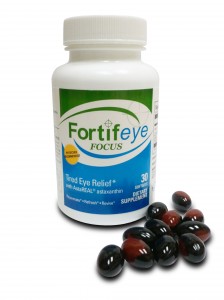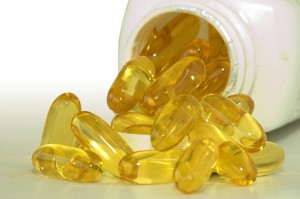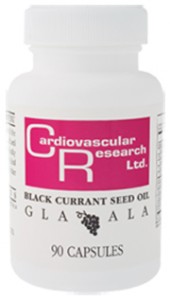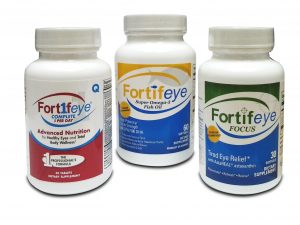New relief in dry eyes and tired eyes – Fortifeye Dry Eye Extreme for natural dry eye relief
Michael Lange O.D. C.N.S. reviews new dry eye/ tired eye management with proper supplementation from Fortifeye Vitamins. Fortifeye Dry Eye Extreme (not yet available) is a new dry eye therapy that is doctor formulated and has been carefully designed to utilize the benefits of combining omega 3 fish oil, gamma linolenic acid (GLA) and astaxanthin.
Dry eye syndrome (keratoconjunctivitis sicca) is an imbalance between tear production and tear drainage. This condition affects nearly 60 million Americans.
 What are dry eye symptoms? Eyes that are red, that feel sandy, gritty or burn, or that tear and itch can be symptoms of dry eyes. Fluctuation in vision, contact lens intolerance and recurrent infections can also be related to dry eyes. Dry red eyes, dry itchy eyes, dry sore eyes, dry burning eyes and dry tired eyes are oftentimes the chief complaints of patients coming into see an eye care provider, urgent care center or primary care physician.
What are dry eye symptoms? Eyes that are red, that feel sandy, gritty or burn, or that tear and itch can be symptoms of dry eyes. Fluctuation in vision, contact lens intolerance and recurrent infections can also be related to dry eyes. Dry red eyes, dry itchy eyes, dry sore eyes, dry burning eyes and dry tired eyes are oftentimes the chief complaints of patients coming into see an eye care provider, urgent care center or primary care physician.
Dry eye syndrome and the causes of dry, itchy eyes
Dry eye syndrome is often misdiagnosed as a form of conjunctivitis or pink eye and sufferers are put on unnecessary medications. Many patients with chronic dry eyes or severe dry eyes are looking for a magical cure for dry eyes and see a multitude of different eye and health providers in search for a dry eye cure. There is no cure for dry eye syndrome, however dry eye treatment can be initiated by an eye care provider and proper nutrition can help manage these chronic dry eye patients quite well. What are some examples of dry eye causes?  Many things can cause dry eyes such as environmental factors, job, medications, contact lenses, systemic health problems, age and eye surgery. Currently, artificial tears and prescription topical medications are the gold standard for the treatment of dry eyes. In treating dry eyes it is important to address the entire system and not just treat topically. More and more evidence now suggests that proper nutrition may help to decrease the symptoms of dry eye and give significant dry eye relief.
Many things can cause dry eyes such as environmental factors, job, medications, contact lenses, systemic health problems, age and eye surgery. Currently, artificial tears and prescription topical medications are the gold standard for the treatment of dry eyes. In treating dry eyes it is important to address the entire system and not just treat topically. More and more evidence now suggests that proper nutrition may help to decrease the symptoms of dry eye and give significant dry eye relief.
A balance of omega-3 and omega-6 essential fatty acids, black currant oil, vitamins and astaxanthin
Oral supplementation with essential fatty acids (EFAs) via omega-3 fish oils and gamma linolenic acid (GLA) is now rapidly becoming an effective tool that optometrists and ophthalmologists are using in clinical practice to help with dry eyes. A synergistic balance between omega-3 and omega-6 EFAs seems to work best for dye eye patients. A lot of time and research on the benefits of omega-3, omega-6, GLA, astaxanthin and various other complementary nutrients has gone into the reformulation of Fortifeye’s newest product called Fortifeye Dry Eye Extreme.
Fortifeye’s first dry eye product was called Fortifeye Dry Eye Therapy  and was used for years with great success, however the Fortifeye team consisting of physicians from all aspects of health care wanted to make a good thing even better. Fortifeye discontinued their current dry eye therapy product and developed a much more bioavailable and more concentrated omega three fish oil called Fortifeye Super Omega. This is a triglyceride based omega-3 fish oil with an EPA of 860 and DHA of 580 in two gel caps. This fish oil has been used successfully alone to help many dry eye patients with mild to moderate dry eye. Fortifeye decided to add some additional nutrients to further enhance the effects of the product and potentially help the moderate to severe dry eye patients. After careful research black currant seed oil and a super carotenoid called astaxanthin were added to the Fortifeye Super Omega fish oil product creating Fortifeye Dry Eye Extreme.
and was used for years with great success, however the Fortifeye team consisting of physicians from all aspects of health care wanted to make a good thing even better. Fortifeye discontinued their current dry eye therapy product and developed a much more bioavailable and more concentrated omega three fish oil called Fortifeye Super Omega. This is a triglyceride based omega-3 fish oil with an EPA of 860 and DHA of 580 in two gel caps. This fish oil has been used successfully alone to help many dry eye patients with mild to moderate dry eye. Fortifeye decided to add some additional nutrients to further enhance the effects of the product and potentially help the moderate to severe dry eye patients. After careful research black currant seed oil and a super carotenoid called astaxanthin were added to the Fortifeye Super Omega fish oil product creating Fortifeye Dry Eye Extreme.
Triglyceride based fish oil when combined with astaxanthin

Dr. Lange and Dr. Eiji Yamashita, a world authority on a super carotenoid currently being utilized in new vitamin formulations.
Fortifeye Dry Eye Extreme is the first in the industry to use high levels of triglyceride based fish oil combined with GLA from black currant oil and astaxanthin. Astaxanthin is a relatively new nutrient used in supplements that comes from microalga Haematococcus pluvialis and is proving to have multiple health benefits. The carotenoid astaxanthin is the reason lobsters, shrimp and some crabs turn red when cooked. While it constitutes a tiny portion of farm-raised salmon feed (50 to 100 parts per million), astaxanthin represents up to 20 percent of the cost. Astaxanthin is an extremely potent antioxidant and anti-inflammatory. Clinical studies have now proven that 6mg of astaxanthin can improve the blood flow to the eye and actually aid in accommodation (focusing) and in reducing eye fatigue. Astaxanthin reduces inflammatory markers such as nitric oxide synthase (NOS), prostaglandin E2 (PGE2) and tumor necrosis factor (TNF). These remarkable aspects of astaxanthin are why Fortifeye Vitamins has incorporated it into their new dry eye vitamin formula called Fortifeye Dry Eye Extreme.
astaxanthin represents up to 20 percent of the cost. Astaxanthin is an extremely potent antioxidant and anti-inflammatory. Clinical studies have now proven that 6mg of astaxanthin can improve the blood flow to the eye and actually aid in accommodation (focusing) and in reducing eye fatigue. Astaxanthin reduces inflammatory markers such as nitric oxide synthase (NOS), prostaglandin E2 (PGE2) and tumor necrosis factor (TNF). These remarkable aspects of astaxanthin are why Fortifeye Vitamins has incorporated it into their new dry eye vitamin formula called Fortifeye Dry Eye Extreme.
Vitamin D deficiency
Fortifeye Dry Eye Extreme recommended for patients with dry eyes and tired eyes. C-reactive protein (CRP) is a protein found in the blood, the levels of which rise in response to inflammation. Vitamin D deficiency is quite common in America. Patients with vitamin D deficiency are more prone to have elevated CRP and elevated TNF (tumor necrosis factor) and have an increased risk of inflammatory diseases in the body. Vitamin D deficiency is now being linked to many eye related problems. Vitamin D3 has been added to help quell this inflammation. Relatively new research has also indicated that vitamin C along with its antioxidant benefits is capable of lowering C-reactive protein as well. Because of this potential added benefit, vitamin C has also been added along with vitamin D3.
Triple molecularly distilled to remove PCBs and other pollutants
Research has found that high dietary intake of omega-3 EFAs (essential fatty acids) decreases the risk of dry eyes. One must be very careful today when increasing their levels of omega-3 EFAs by consuming more fish. PCBs (polychlorinated biphenyls) are persistent organic pollutants banned in 1979 but still present in ocean waters. Even fish that are caught in the Arctic regions can be contaminated due to the fact that airborne contaminants within the atmosphere will condense at lower temperatures and precipitate into this environment. Fish can be contaminated with mercury, lead, PCBs, dyes and other contaminants. Molecularly distilled fish oil is a convenient and safe way of getting the omega-3 EFAs and removing pollutants. We would never consider using fish oils that have not been refined to reduce contaminant levels to an undetectable amount.
One must be very careful today when increasing their levels of omega-3 EFAs by consuming more fish. PCBs (polychlorinated biphenyls) are persistent organic pollutants banned in 1979 but still present in ocean waters. Even fish that are caught in the Arctic regions can be contaminated due to the fact that airborne contaminants within the atmosphere will condense at lower temperatures and precipitate into this environment. Fish can be contaminated with mercury, lead, PCBs, dyes and other contaminants. Molecularly distilled fish oil is a convenient and safe way of getting the omega-3 EFAs and removing pollutants. We would never consider using fish oils that have not been refined to reduce contaminant levels to an undetectable amount.
The benefits of omega-3 fish oil to reduce inflammation
EPA (eicosapentaenoic acid) and DHA (docosahexaenoic acid) are the two principal EFAs (essential fatty acids) found in fish known as omega-3 fatty acids. The current research suggests the anti-inflammatory effects of fish oil may help with dry eye syndrome. EPA generates the anti-inflammatory eicosanoids prostaglandin E3 and leukotriene B5.  If the concentration of EPA is high enough the EPA blocks the delta-5 desaturase enzymatic step that stops the conversion of omega-6 EFAs to the inflammatory cascade of arachidonic acid (AA). This allows more conversion to anti-inflammatory prostaglandin E1 (PGE1). PGE1 then binds to EP2 and EP4 receptors to activate adenylate cyclase and increase cyclic AMP (adenosine monophosphate) which in turn stimulates a healthier tear production. The increase in omega-3 EFAs have also shown to improve dysfunction in the meibomian gland with a much thinner and clearer meibomian gland secretion thus helping with meibomian gland dysfunction. The increased consumption of a triple molecularly distilled and concentrated omega-3 fish oil will help to get the balance between omega-6 and omega-3 in better harmony and allows for less inflammation in the body and eyes. Americans have a much too high percentage of pro-inflammatory omega-6 in their diet. The addition of a good omega-3 fish oil is the start to a healthier body and visual system. Fortifeye Super omega in two per day dosing clinical omega index blood testing has brought the omega index level consistently between 9.2-11 . The therapeutic goal is to be over 8% to gaine the valuable health benefits of omega 3.
If the concentration of EPA is high enough the EPA blocks the delta-5 desaturase enzymatic step that stops the conversion of omega-6 EFAs to the inflammatory cascade of arachidonic acid (AA). This allows more conversion to anti-inflammatory prostaglandin E1 (PGE1). PGE1 then binds to EP2 and EP4 receptors to activate adenylate cyclase and increase cyclic AMP (adenosine monophosphate) which in turn stimulates a healthier tear production. The increase in omega-3 EFAs have also shown to improve dysfunction in the meibomian gland with a much thinner and clearer meibomian gland secretion thus helping with meibomian gland dysfunction. The increased consumption of a triple molecularly distilled and concentrated omega-3 fish oil will help to get the balance between omega-6 and omega-3 in better harmony and allows for less inflammation in the body and eyes. Americans have a much too high percentage of pro-inflammatory omega-6 in their diet. The addition of a good omega-3 fish oil is the start to a healthier body and visual system. Fortifeye Super omega in two per day dosing clinical omega index blood testing has brought the omega index level consistently between 9.2-11 . The therapeutic goal is to be over 8% to gaine the valuable health benefits of omega 3.
Omega-6 and astaxanthin for improved tear production
Gamma-linolenic acid (GLA) is an essential fatty acid (EFA) in the omega-6 family that is found mainly in plant seed oils. The three most common plant seed oils where GLA are found are borage seed oil, black currant oil and evening primrose oil. GLA is broken down in the body to dihomo-gamma-linolenic acid (DGLA) and arachidonic acid (AA). DGLA competes with AA and prevents the negative inflammatory effects that AA would otherwise cause. Adequate amounts of magnesium, zinc and vitamins C, B3 and B6 help to promote the conversion of GLA to DGLA rather than AA. Researchers in Japan have shown that astaxanthin may suppress the cyclooxygenase enzyme and decrease the amount of pro-inflammatory PGE2 produced.  Once the AA pathway is blocked the DGLA is free to convert to anti-inflammatory prostaglandin E1 (PGE1) and stimulation of tear production occurs. Recent studies suggest that oral GLA supplementation improved dry eye both clinically and subjectively in patients with dry eye syndrome. Studies also show that patients who take a combination of linoleic acid (LA) and gamma-linoleic acid (GLA) prior to and after refractive surgery may have better tear production and less dry eye complications. Studies utilizing GLA and omega -3 fish oil have shown an additive anti-inflammatory effect with no elevation in arachidonic acid. Due to the extremely high amounts of omega-6 in most diets, Fortifeye has decided to use a ratio of approximately 10 to 1 omega-3 to omega-6 to maximize the anti-inflammatory effects and gain full advantage of both types of essential fatty acids. If the ratio of omega-6 (GLA) to omega-3 is too high in the omega-6 direction then the possibility of more inflammation related to the high omega-6 low omega-3 ratio exists.
Once the AA pathway is blocked the DGLA is free to convert to anti-inflammatory prostaglandin E1 (PGE1) and stimulation of tear production occurs. Recent studies suggest that oral GLA supplementation improved dry eye both clinically and subjectively in patients with dry eye syndrome. Studies also show that patients who take a combination of linoleic acid (LA) and gamma-linoleic acid (GLA) prior to and after refractive surgery may have better tear production and less dry eye complications. Studies utilizing GLA and omega -3 fish oil have shown an additive anti-inflammatory effect with no elevation in arachidonic acid. Due to the extremely high amounts of omega-6 in most diets, Fortifeye has decided to use a ratio of approximately 10 to 1 omega-3 to omega-6 to maximize the anti-inflammatory effects and gain full advantage of both types of essential fatty acids. If the ratio of omega-6 (GLA) to omega-3 is too high in the omega-6 direction then the possibility of more inflammation related to the high omega-6 low omega-3 ratio exists.
Relief for dry eye sufferers through the latest research
The potential benefits for current and future dry eye sufferers from a carefully designed oral nutritional supplement for dry eye is huge. Fortify Vitamins Inc. has developed a synergistic blend of triple distilled omega-3 triglyceride based fish oil, plus gamma linolenic acid (GLA) from black currant oil, astaxanthin, and other nutritional cofactors that is based on the latest research. This formula combines all of the latest developments in nutrition necessary to aid in the alleviation of signs and symptoms of dry eye syndrome and eye fatigue.  Fortifeye Dry Eye Extreme is doctor-formulated and has been carefully designed to utilize these nutrients synergistically. Fortifeye vitamins are currently being used by thousands of patients around the world with great success. This formula is great for patients to use prior to and after Lasik and cataract surgery to help minimize post operative dry eye symptoms and inflammation. Many dry eye contact lens intolerant patients may benefit from using this supplement. Computers users, eye strain and dry eye fatigue
Fortifeye Dry Eye Extreme is doctor-formulated and has been carefully designed to utilize these nutrients synergistically. Fortifeye vitamins are currently being used by thousands of patients around the world with great success. This formula is great for patients to use prior to and after Lasik and cataract surgery to help minimize post operative dry eye symptoms and inflammation. Many dry eye contact lens intolerant patients may benefit from using this supplement. Computers users, eye strain and dry eye fatigue
A large population that may be helped from this new health supplement is the computer users. Computer use generates significant eye strain and dry eyes.  Computer related dry eyes and eye fatigue ultimately leads to a condition called Computer Vision Syndrome (CVS). Fortifeye Dry Eye Extreme may be just what computer users have been waiting for. I have had many patients reduce their eye strain and fatigue while working on the computer when they utilize the proper supplementation. The triple whammy for Dry , tired eyes from prolonged computer work is Fortifeye Focus, Fortifeye Super Omega and GLA from Black Currant seed oil. These three supplements work synergistically together to help reduce dry eye symptoms.
Computer related dry eyes and eye fatigue ultimately leads to a condition called Computer Vision Syndrome (CVS). Fortifeye Dry Eye Extreme may be just what computer users have been waiting for. I have had many patients reduce their eye strain and fatigue while working on the computer when they utilize the proper supplementation. The triple whammy for Dry , tired eyes from prolonged computer work is Fortifeye Focus, Fortifeye Super Omega and GLA from Black Currant seed oil. These three supplements work synergistically together to help reduce dry eye symptoms.
The future therapy for dry and tired eyes is here now!
Patients who have been diagnosed with dry eye syndrome who want to be proactive in the health of their eyes should consider the natural approach at managing dry eyes with Fortifeye Dry Eye Extreme (will be available by 2014). The exact formula that will be avaialble in 2014 is available now !! Simply combine Fortifeye Focus taking (1) per day, Fortifeye Super Omega-3 taking (2) per day and Cardiovascular Research Black Currant Seed oil taking 2 per day. These three supplements combined will give the exact ratio that has been used in large dry eye practices with great success. We also recommend adding Fortifeye One per day if you arent taking a good multivitamin or eating 10-13 servings of fruits and vegetables a day. This supplement regiment is not only the most advanced supplement regiment for dry eyes but will also give the nutrients the entire body is thirsting for. These supplements do not replace a comprehensive eye exam and we recommend seeing your Optometrist or ophthalmologist routinely. At checkout Apply Coupon Code Multi3 to receive 15% off (3) or more Fortifeye Products.
!! Simply combine Fortifeye Focus taking (1) per day, Fortifeye Super Omega-3 taking (2) per day and Cardiovascular Research Black Currant Seed oil taking 2 per day. These three supplements combined will give the exact ratio that has been used in large dry eye practices with great success. We also recommend adding Fortifeye One per day if you arent taking a good multivitamin or eating 10-13 servings of fruits and vegetables a day. This supplement regiment is not only the most advanced supplement regiment for dry eyes but will also give the nutrients the entire body is thirsting for. These supplements do not replace a comprehensive eye exam and we recommend seeing your Optometrist or ophthalmologist routinely. At checkout Apply Coupon Code Multi3 to receive 15% off (3) or more Fortifeye Products.
Read the very latest on Natural treatment of dry eyes and meibomian gland dysfunction here: http://dryeyetreatmentblog.com/2013/10/07/dry-eye-treatment-and-meibomian-gland-dysfunction-a-natural-approach-by-michael-lange-od/
 Dr. Michael P. Lange
Dr. Michael P. Lange
Board Certified Optometric Physician
Certified Nutrition Specialist
Syndicated Daily Talk Show Host (Ask the Doctor)
www.langeeyecare.com
old.fortifeye.com
May 5, 2011, revised 09/02/13
________________________________________
REFERENCES
Association for Research in Vision and Opthalmology (2003). Research Symposium Findings. Fort Lauderdale, Fla., May 4-9, program numbers 811, 2111, and 2112.
Barham JB et al (2000). Addition of EPA to GLA-supplemented diets prevents serun AA accumulation in humans Nutrition, August (130), 1925-31.
Barham JB, Edens MB, et al. Addition of Eicosapentanoic Acid to Gamma-linolenic acid? Supplemental Diets Prevents Serum Arachidonic Acid Accumulation in Humans. J of Nutrtion, 2001; 130: 1925-1931
Block G, Jensen CD, Dalvi TB, Norkus EP, Hudes M, Crawford PB, Holland N, Fung EB, Schumacher L, Harmatz P, Vitamin C treatment reduces elevated C-reactive protein. University of California, Berkeley, 94720, USA
Brown NA, et al (1998). Nutrition supplements and the eye. Eye, 12, 127-133.
J. Dyerberg, P. Madsen, J Moller, I. Aardestrup, E. B. Schmidt, Bioavailability of n-3 fatty acid formulations; N-3 Fatty Acids; Prevention and Treatment in Vascular Disease, 1995 : 217-226
Iwasaki & Tawara, (2006). Effects of Astaxanthin on Eyestrain Induced by Accommodative Dysfunction. Journal of Eye (Atarashii Ganka) (6):829-834.
.
Miljanovic B, Trivedi KA, Dana MR, et al. Relation between dietary n-3 and n-6 fatty acids and clinically diagnosed dry eye syndrome in women. Am J Clin Nutr. 2005;82:887-893.
Miyawaki et al., (2005). Effects of astaxanthin on human blood rheology. J. Clin. Therap. Med., 21(4):421-429.
Nagaki Y., et al., (2002). Effects of astaxanthin on accommodation, critical flicker fusions, and pattern evoked potential in visual display terminal workers. J. Trad. Med., 19(5):170-173.
Nagaki et al. (2005). The effects of astaxanthin on retinal capillary
Nagaki et al., (2006). The supplementation effect of astaxanthin on accommodation and asthenopia. J. Clin. Therap. Med., 22(1):41-54.
Nakamura et al. (2004). Changes in Visual Function Following Peroral Astaxanthin. Japan J. Clin. Opthal., 58(6):1051-1054.
Nitta et al. (2005). Effects of astaxanthin on accommodation and asthenopia – Dose finding study in healthy volunteers. J. Clin. Therap. Med., 21(6):637-650.
Ohgami et al., (2003). Effects of astaxanthin on lipopolysaccharide-induced inflammation in vitro and in vivo. Invest. Ophthal. Vis. Sci., 44(6):2694-2701.
Sawaki, K. et al. (2002) Sports performance benefits from taking natural astaxanthin characterized by visual activity and muscle fatigue improvements in humans. J. Clin. Ther. Med., 18(9):73-88.
Shimizu S et al (1991). Sesamin is a potent and specific inhibitor of delta 5 desaturase in polyunsaturated fatty acid biosynthesis. Lipids. Aug, 26(7), 512-6.
Shiratori et al. (2005). Effect of astaxanthin on accommodation and asthenopia – Efficacy identification study in healthy volunteers. J. Clin. Therap. Med., 21(5):543-556.
Suzuki et al., (2006). Suppressive effects of astaxanthin against rat endotoxin-induced uveitis by inhibiting the NF-kB signaling pathway. Exp. Eye Res., 82:275-281.
Takahashi & Kajita (2005). Effects of astaxanthin on accommodative recovery. J. Clin. Therap. Med., 21(4):431-436. blood flow in normal volunteers. J. Clin. Therap. Med., 21(5):537-542.
Thornton A (2003). Nutrients restore tear function in dry eye syndrome. Ophthalmology Times, May 12, special section.
Tobias Pischon, Susan Hankinson, Gokhan Hotamisligil, Nader Rifai, Walter Willett and Eric Rimm (2003) Habitual Dietary intake of omega-3 and omega-6 fatty acids in relation to inflammatory markers among US men and women. Circulation 2003; 108;155-160
Wu D, et al (1999). Effect of dietary supplement with black currant seed oil on the immune response of healthy elderly subjects. American Journal Clinical Nutrition, 70, 536-543
Sheppard, John D. Jr., Singh, Ruhi: McClellan, Andrew J: Weikert, Mitchell P.: Scoper, Stephen V.:Joly, Thomas J: Whitley, Walter O: Kakkar, Ekta: Pflugfelder, Stephen C. , 2013, Long term supplementation with n-6 and n-3 PUFAs improves moderate to severe keratoconjunctivitis sicca: a randomized double blind clinical trial





